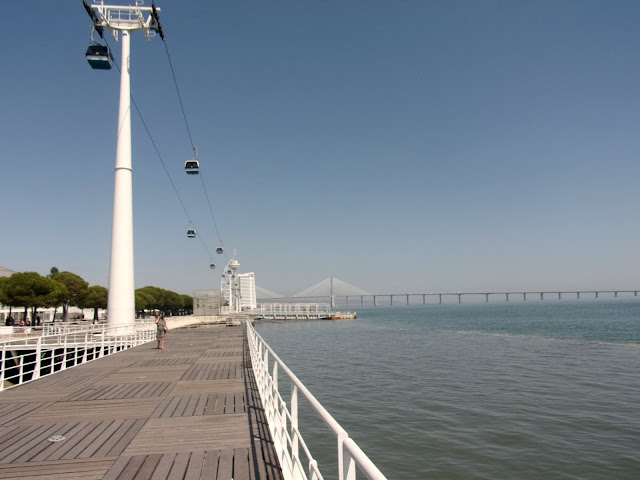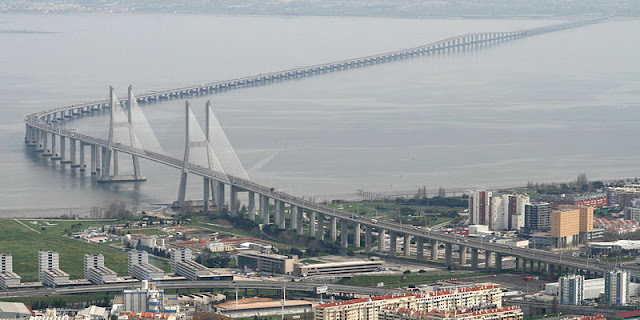This post is based primarily on
Don's notes, occasionally supplemented with MT's notes from our Camino in 2016.
When information from other sources is added—for further explanation to readers
or to satisfy our own curiosity—that is set off in a text box (as this one).
Most of the photos that accompany
this post are from Don’s camera (with a caption indicating the time it was
taken); those from MT’s iPhone are indicated by “MT” placed at the beginning of
the photo caption. Photos from any other source (such as the public domain Wikimedia
Commons) indicate that source in the caption.
We awoke at almost 8 am, since the reception desk failed to give us a wake-up call. We ate breakfast (included) at Hotel Botanico. When we departed at 10 am, the desk clerk said we had to pay a €2 hotel tax (of the City of Lisbon), which our Follow the Camino voucher didn’t include.
Using
our pass still valid from the day before, we took the Metro from the Avenida
station to the Baixa-Chiado station and then walked to the Cathedral to start the Camino.
According to Brierley’s notes, “The
first waymark appears right of the cathedral steps,” but we found no such
marking. It was good that we had Brierley’s instruction on what streets to
take, since the way was VERY poorly marked. There was only the occasional sign
with yellow arrows (and blue for Fátima, since the first part of our route was
shared by both destinations) and an occasional spray-painted yellow arrow.
10:39 AM - Lisbon: first blue and yellow arrow sign,
near Cathedral.
MT 10:59 AM -Lisbon: another blue and yellow arrow
sign.
Sometimes
we had to ask people on the street where there was no street name sign. We
eventually found a paved passeio
(walkway, promenade) along the riverfront (not a natural pathway as in
Brierley) toward the Vasco da Gama bridge.
The Ponte de Vasco da Gama (Vasco da Gama Bridge), inaugurated in 1998,
is 17.2 km (10.7 mi) long*, the longest bridge in Europe. It spans the Tagus
River.
*Both Brierley and the Wikipedia
entry on Lisbon report the length as around 17 km. However, the Wikipedia entry
on the bridge says it “is a cable-stayed bridge flanked by viaducts” and says:
“It is the longest bridge in Europe (including viaducts), with a total length
of 12.3 km (7.6 mi), including 0.8 kilometers (0.50 mi) for the main bridge and
11.5 kilometers (7.1 mi) in viaducts.”
12:40 PM - Lisbon: boardwalk and Ponte de Vasco da Gama
with Telecabina overhead tramway.
MT 12:47 PM – Lisbon: Don and MT on boardwalk and Ponte de Vasco da Gama bridge.
12:49 PM – Lisbon: boardwalk and Ponte de Vasco da Gama with Telecabina overhead tramway.
12:49 PM – Lisbon: more of 17-km-long Vasco da Gama bridge.
Lisbon: Ponte de Vasco da Gama – aerial view (en.wikipedia.org).
Then
we arrived at the Parque das Nações.
The Parque das Nações (Park of the Nations) is the newest district in
Lisbon, with a futuristic look resulting from an urban renewal program leading
to the World Exhibition of Lisbon 1998, also known as Expo’98.
MT 1:01 PM – Lisbon: Parque das Nações - MT with funny (Smurf-like) statue by river walk.
MT 1:00 PM – Lisbon: Parque das Nações - Don with funny (Smurf-like) statue by river walk.
12:55 PM – Lisbon: Parque das Nações - the twin Torre São Gabriel towers and flags of nations, near river walk and funny statue.
Near
the Vasco da Gama bridge, we came to a statue of Catarina de Bragança.
Catarina
de Bragança
(1638-1705) was the daughter of King João IV of Portugal, who was of the House
of Bragança. She left Lisbon in 1662 to marry Charles II of England. Her dowry
included Bombay and tea. She and her court introduced tea and “tea time” to
England. Beyond tea, her arrival in England brought and promulgated goods such
as cane, lacquer, cottons, and porcelain. The borough of Queens in New York
City was supposedly named after her, since she was queen when Queens County was
established in 1683. Queens’ naming is consistent with that of Kings County
(the borough of Brooklyn, originally named after her husband King Charles II).
1:18 PM – Lisbon: Camino arrows, statue of Catarina de
Bragança and Vasco da Gama bridge.
1:18 PM – Lisbon: statue of Catarina de Bragança (close-up).
1:24 PM – Lisbon: Vasco da Gama bridge.
1:25 PM – Lisbon: Vasco da Gama bridge, with coat of arms.
1:29 PM – Lisbon: Vasco da Gama bridge, stretching into distance.
MT 2:09 PM - Near Sacavém: Don with large sculpture of head.
MT 2:10 PM - Near Sacavém: MT with large sculpture of head.
When
we got to the N-10 at Ponte (bridge) Sacavém and had crossed the bridge around
2 pm, a local couple told us to continue on the N-10 highway for Fátima, but we
explained that we were not going to Fátima and instead followed the yellow (and
blue) arrows that led to a narrow gravel path along the river. After a
kilometer or so, we stopped for water (from our bottles) and Don again asked MT
if we should have just stayed on the N-10 to Santa Iria de Azóia (where we
would stay that night) as he had suggested in notes he had made on our voucher
and had suggested to her on the plane (she had said no, but to just follow the
designated Camino route) and again before we left Lisbon. Don had told her at
our rest stop near the Vasco da Gama bridge that our next decision point was at
the N-10 at Sacavém. Brierley’s distance graph had shown us a little more than
15 km from Lisbon to Póvoa de Sta. Iria and then another 1.8 km back south on
the N-10 to the hotel in Sta. Iria. However, we now added up the distances
between points on Brierley’s map after N-10 Ponte Sacavém to Póvoa de Sta.
Iria, which totaled 12.7 km; adding the 1.8 km back to Sta. Iria, that would be
14.5 km, which was still a very long way to go. Looking at Brierley’s map, Don
estimated that the distance from Sacavém to Sta. Iria on N-10 was only about
3.6 km (it looked to be about twice as far as the 1.8 km from Póvoa de Sta.
Iria to Sta. Iria). So we went back to the N-10 and followed it to Santa Iria (2:30-3:45 pm), where we
arrived at Hotel VIP Executive (4 star) after help from a local at a shop on
the road, who spoke English and Italian.
Santa
Iria de Azóia
(pop. 18,240) is named for Santa Iria.
Santa
Iria
(c.635-c.653) is known in English as Saint Irene of Tomar. She was a Christian
who was martyred for her faith in Visigothic Portugal. Legend says that she was
born in Nabância (present-day Tomar) to an influential family. Her parents sent
her to a Benedictine convent school and a private tutor. A young nobleman named
Britald fell desperately in love with her and proposed, but she declined,
having already given herself to God as a nun. Her tutor then made improper
advances to her and, when she declined, spread the rumor that she was pregnant.
When Britald heard of his beloved’s supposed infidelity, he hired a mercenary
soldier to kill her. As she was returning home from visiting an elderly
cripple, the assassin killed her with a single stroke of his sword and threw
her body into the River Tagus. Later, her body was discovered, uncorrupted by
the river, by Benedictines near the town of Escálabis. The monks gave her a
proper burial and spread her cult. Eventually, the reverence paid the virgin
saint was so great, that the old Roman name of the town of Escálabis was
changed to Santa Iria, which eventually changed to Sancta Irene and thence to
Santarém. She is usually depicted as a nun, holding the palm of martyrdom in
her hand.
On
the way into Sta. Iria, we stopped at a roadside “mom and pop” fruit and
vegetable stand. MT bought 4 bananas, 1 red plum, and ½ kg of figs for about
€1. When we arrived at the hotel, Don ate 1 banana and the plum, and MT ate
figs.
3:33 PM – Santa Iria de Azóia: "Bem Vindo" (welcome) sign to the freguesia (civil parish) of Santa Iria de Azóia.
MT 3:56 PM – Santa Iria de Azóia: MT at sign entering town.
MT 3:56 PM – Santa Iria de Azóia: Don at sign entering town.
We
arrived at the Hotel VIP Executive (4
star) around 4 pm and got our carimbo
stamp for the day at the hotel’s recepcão (reception) desk .
4:00 PM – Santa Iria de Azóia: Hotel VIP Executive, front side.
Santa Iria de Azóia: carimbo stamp from "Hotel VIP Santa Iria Recepcão."
6:02 PM – Santa Iria de Azóia: Hotel VIP Executive, pools from our room, thru sheer curtains.
MT
visited the swimming pool, while Don showered. We washed clothes and hung them
to dry.
At
7:30 pm, we went down to the buffet dinner in the hotel (without the half board
included on our voucher, the buffet was €15 ea, or €17 with wine). We started
with soup. There was a wide selection of salads, and we both had a green salad
with tomatoes (Don added shredded carrots, and MT added garbanzos), and we both
tried polvo (octopus) in a marinated
salad with onions. For the main course, we both had warm polvo and grilled turkey breast with “cooked” (boiled) potatoes and
mixed vegetables. For desert, we both had a small slice of a flaky, layered tarta (cake); Don also had cheesecake/MT
crème caramel. The dinner also included bread and (2 glasses each of) red wine
of the area. The waiter offered us a third glass of wine. MT also got smoked
salmon.
MT 7:55 PM – Santa Iria de Azóia: Hotel VIP Executive – potatoes and polvo (octopus) on buffet.
7:49 PM – Santa Iria de Azóia: Hotel VIP Executive – dinner main course.
8:14 PM – Santa Iria de Azóia: Hotel VIP Executive – MT’s fruit salad, tarta, and crème caramel.


























No comments:
Post a Comment